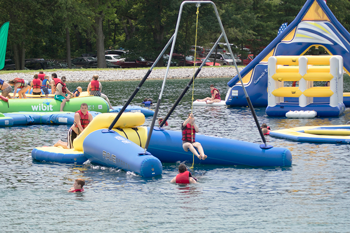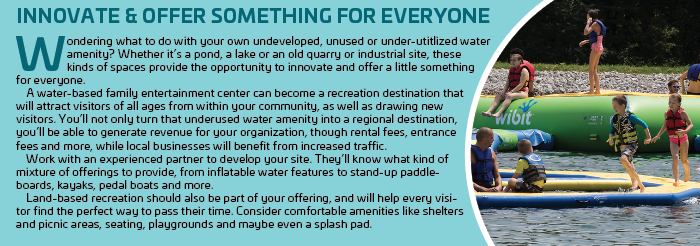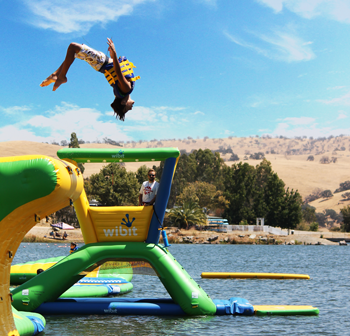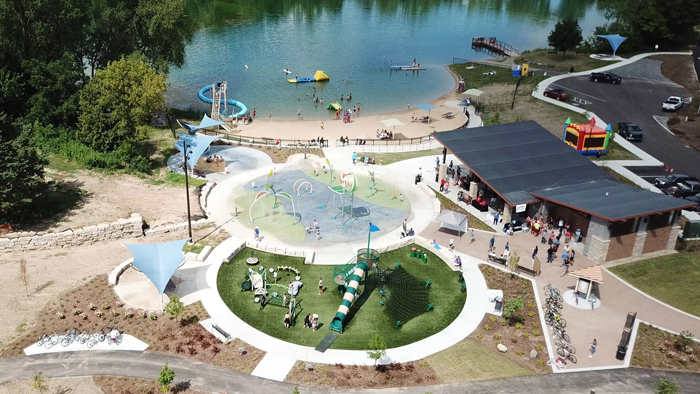It seems that people are innately drawn to water. In his bestselling book Blue Mind, Ph.D. and marine biologist Wallace J. Nichols focuses on the proven scientific evidence that being close to bodies of water promotes mental health and happiness. Research has found it can lower stress and anxiety, boost creativity and even lower heart and breathing rates. Real estate data suggests a water view tacks on a 116% premium to a property, and other figures suggest we’re willing to pay 10% to 20% more for the same room with a sea view in a hotel.
And if water truly attracts people, it makes sense that cities and towns that have this resource—whether oceanfront, rivers, lakes or canals—would want to capitalize on it. However, throughout our history, these waterfront areas were often utilized for industrial and manufacturing purposes, as well as ways to move goods around. And as these industries have largely been abandoned, waterfront areas commonly became neglected eyesores and brownfields, populated by abandoned factories and warehouses, concrete, trash and dangerous chemicals.

But more communities are gradually working to take back their waterfronts and transform them into vibrant recreation areas featuring river walks, parks, event spaces and water activities, not only for residents but also to attract tourist dollars, businesses and potential new residents.
In Detroit, the nonprofit Detroit Riverfront Conservancy (DRFC) was born in 2003 with a vision to “transform Detroit’s international riverfront into a beautiful, exciting, safe, accessible world-class gathering place for all.” They’re responsible for the establishment, improvement, operation, maintenance, security, programming and expansion of the Detroit RiverWalk and associated green spaces.
Marc Pasco is director of communications for the DRFC, and he described how for a long time, Detroit residents would look across the Detroit River to Canada and admire their waterfront, which featured events, art, pathways and greenspaces. “For years people here would look over there and think, ‘Why can’t we have something like that?’” Pasco said the planets really aligned when the conservancy launched along with launch partners the City of Detroit, the Kresge Foundation and General Motors, which donated the first half mile of the RiverWalk.
“The riverfront has undergone a tremendous transformation and revitalization,” Pasco explained. “It used to be cement silos, abandoned buildings, weeded lots and burned-out cars. There was very little public access; it wasn’t very safe.”
And while there are still some buildings and lots to be transformed, there are now more than 3 million visitors a year to the riverfront, enjoying parks, plazas, pathways, a splash pad, public art, restaurants, special events, free programming and more. “It’s completely changed now”, said Pasco, who mentioned that the Detroit RiverWalk was voted Best Riverwalk in the USA in 2021 and 2022 by USA Today.
The vision is for the RiverWalk to stretch for 5.5 miles. The East Riverfront, which is 3.5 miles, will be finished this year with the opening of the Uniroyal Promenade, a former tire factory site that’s been developed. The West Riverfront, which still has some work to go, will ultimately be two miles.
“The Detroit Riverfront is a mixture of public and privately owned land,” said Pasco. “From the beginning of the conservancy, part of our success and the revitalization of the riverfront is those public/private partnerships.” He explained that they’ve worked with people and entities across those relationships, so that whoever owns the land, the conservancy maintains an easement and manages the RiverWalk.

When it comes to maintaining the beautiful landscapes and fixing things when necessary, Pasco said they employ a director of operations and security, who oversees a team of workers. “Security is something we take very seriously along the riverfront; if people didn’t feel safe, people wouldn’t come down. Likewise with the maintenance; if it wasn’t kept up and the snow wasn’t plowed, the flowers weren’t blooming and the grass wasn’t cut, things like that, people wouldn’t come down.” He described how even in the winter, flower boxes might contain greenery and pinecones. In fact, visitors are drawn to the riverfront even in winter for oversized fires, sleds, s’mores, games, food and drinks, winter wellness activities and other events including the Fire & Ice Festival, Winter around the World and a Mardi Gras celebration.
As far as water activities, Pasco pointed out that people really like fishing, “so every time we open a park, we always make sure we have places where people can fish,” which might be piers or outlooks. And while there are no appropriate places to swim, “along the riverfront, if you want to put your toes in the sand, at our newest park there’s a beach area.” Robert C. Valde Park also features Adirondack chairs and umbrellas, a children’s musical garden and other play structures, a barbeque pavilion, a floating bar and The Shed, a 3,600-square-foot building for programming and events. There are also boat tours along the riverfront offered by private companies.
Pasco also described “a couple great connectors that help get people to the riverfront,” including a City of Detroit project: a pedestrian-only greenway. “The other is the Dequindre Cut, and that used to be a railway and now it’s a two-mile-long greenway, no cars allowed,” which offers a pedestrian link between the East Riverfront, the famous Eastern Market and several residential neighborhoods in between. Known for urban examples of artwork and graffiti, the Dequindre Cut features a 20-foot-wide paved pathway with separate pedestrian and bicycle lanes, an outdoor amphitheater and the Freight Yards—a beer garden featuring DJs, live music and food trucks, constructed from old shipping containers.
Formed in 2007, the New York City-based nonprofit Waterfront Alliance strives to make the New York Harbor and surrounding waterways a shared resource for all, while also working to define New York Harbor’s response to sea level rise and coastal storms. Their website states that “we will create healthy, resilient, accessible and equitable waterways that are alive with commerce and recreation, and exciting waterfront destinations that reflect the vitality and diversity of the communities that surround them.” Today, the group has grown into a coalition of more than 1,100 organizations working together.

Recently, Waterfront Alliance released a report titled “Activating New York City-Owned Waterfront Sites for Recreation and Access: Action Plans for Four Underutilized Sites in High-Need Communities.” “We’re focused on identifying locations that provide the opportunities to open unused waterfront properties owned by NYC for under-resourced communities,” said Cortney Koenig Worrall, president and CEO of Waterfront Alliance. “At this point it involves identifying these properties, developing action plans and then making sure we have the opportunity to partner with the city as needed and through our suggestions.”
The team put together a list of questions to help determine which underutilized city-owned sites across the five boroughs were ready and have the right qualities to be transformed into publicly-accessible waterfronts in the near term. Special attention was paid to communities’ racial makeup, income levels and climate change risks, factors that contribute to increased inequity.
After collecting the information, a ranking system was used to narrow down an initial list of 60 sites to four with the most current potential to be activated; two were in Queens, one in the Bronx and one in Staten Island. “To effectively engage the community, we visited each priority site, met with community partners and members and distributed surveys,” said Koenig Worrall.
She said the key to success in this project is listening to the community groups who are already using the sites and building on their vision. “Some of the recreation ideas these groups have thought of include docks for boating and fishing, kayak accessibility, cookout facilities, benches for relaxation and wildlife observation.” Other relatively modest wishes included trash receptacles, pet waste stations, improved signage, water fountains, restrooms, shade trees and native plants, shelter and better site access. “Even modest investments could produce results that include improved resilience, alleviated flooding, improved capture of rainwater runoff to provide further ecological uplift, increased accessibility and increased safety for those in the community.
“In the next phase of the project, we will continue engagement with agencies, officials, civic groups and community organizations,” continued Koenig Worrall, “as well as engage in community-based organizing to advance options such as charrettes and workshops to further advance community-led design and usage, leverage political support, and continue to identify needs for the sites.” Additionally, she said they’d continue discussions with landowners and other stakeholders who own or manage the sites in question.
Another pillar of Waterfront Alliance’s work is educating the next generation of waterfront stewards, which they accomplish through their Estuary Explorers program, which provides context as to why accessible waterfront sites are important to communities surrounded by water, and has been popular with NYC schools near waterfront sites, according to Koenig Worrall. She said that as more waterfronts across New York have become accessible, more teachers are interested in getting their students to engage with the shoreline. “Many of the lessons and activities the students participate in are modeled after actual jobs scientists and technicians do when measuring water quality, helping open the door to potential job opportunities down the road. By raising awareness about the issues climate change poses to waterfronts and how revitalization can be a tool when tackling it, members of the community are oftentimes more open to revitalization to their local waterfronts.”
In Louisville, Ky., Waterfront Park is both a nonprofit organization and a public park bordering the Ohio River. Early river technology tied Louisville to the waterway but—as happened in many cities—by the mid-1800s, railways and roads began to dominate. And while efforts to reestablish a connection between the city and waterfront began as early as 1931, significant barriers still separated them.
Over the decades, desires to reconnect and revitalize the waterfront persisted, and in 1986 the City of Louisville, the Commonwealth of Kentucky and Jefferson County formed a nonprofit to redevelop Louisville’s waterfront, breaking ground in 1992 and birthing Waterfront Park, a vibrant 85-acre site welcoming more than 2.2 million visitors annually.
“Prior to the development of Waterfront Park, the waterfront was disconnected from downtown Louisville,” said Kelley Runyon, director of operations at Waterfront Park. “The river’s edge was dedicated to industrial purposes such as asphalt terminals, sand and gravel yards and scrap yards. The construction of Interstate 64 further created a barrier between Louisville and the river.”
The nonprofit operates under a Fiscal Agency Agreement with Louisville Metro Government, according to Runyon, and Waterfront Park is not part of Louisville Parks and Recreation. Since the completion of the park’s first phases in the mid-1990s, the Waterfront Park staff’s mission has evolved into operations, fundraising, park maintenance, event production and coordination, park planning and construction.
Runyon said the park currently boasts more than five miles of walking trails, tree groves and other passive green space. There is public art displayed and five different picnic areas complete with picnic tables and park grills. There are two play areas including an adventure playground and splash park. There are bicycle rentals and canoeing, kayaking and rowing opportunities at the Community Boathouse. Two sets of boat docks connect the park and waterfront. You can ride the Belle of Louisville, a 100-year-old steamboat and national historical landmark. “Waterfront Park is also home to the Lincoln Memorial, which was commissioned in honor of the Lincoln Bicentennial and is part of the Kentucky Lincoln Heritage Trail,” said Runyon.
Crossing the Ohio River and connecting Waterfront Park to Jeffersonville, Ind., the Big Four Bridge was constructed in 1895, providing rail access for freight and passengers and operating until 1969. In 2013 the City of Louisville unveiled an elliptical ramp and opened the bridge to pedestrians and bicycles. In 2014 the city of Jeffersonville built its own ramp, and now the expanse of bridge and ramps is about two miles. It’s a prime spot for viewing sunsets and at night it features a programmable LED lighting system, becoming a beacon in the city.
Waterfront Park has areas for public and private events, and Runyon said these generate significant revenue that supports park operations and maintenance. “Events range from small family reunions to Kentucky Derby Festival’s Thunder over Louisville event, which draws hundreds of thousands of spectators.”
She listed a few of the many other events—more than 200 per year—including nonprofit/charity walks, concerts, Fleur de Flea Urban Vintage Market, Venardos Circus, food truck events, Pride Festival, beer and wine tasting events, and the Big Four Arts Festival. “These events may have an admission charge and are produced by third parties.”
Runyon also mentioned three events that they produce that are free to the public, including Waterfront Park Fourth of July. There’s also Brunch & Bark by the Bridge, a pet-friendly Sunday tradition where they partner with the Kentucky Humane Society, featuring food trucks, live music, drink specials, vendors and giveaways. And WFPK Waterfront Wednesday is a monthly concert (April through September) featuring big-name regional and national acts with food trucks, cash bar and beautiful river views. Spectators can also watch from the bridge.
Over the years, three phases of work have been completed at Waterfront Park, and a groundbreaking ceremony for the fourth phase was held in October 2022. The new phase utilizes a largely neglected, former heavy industrial site that sits beneath the highway, and will extend and improve an existing walking and bicycle path. “The expansion will include PlayPort (an outdoor experiential learning area), an observation pier, Railyard Plaza, Confluence Plaza, Fort-on-Shore Plaza, Foundry Commons, Midway Connector and Exerscape,” said Runyon. “Phase IV builds on the river history of the area, and these features provide areas for events, community gathering spaces and space for active recreation.”
Private donations from park users, philanthropists and corporations are often crucial to guide a community’s waterfront development vision, as are public funds and grants. “Waterfront Park has always been a public/private partnership, and grants have played a very important role in the construction and ongoing maintenance of the park,” said Runyon.
Back in Detroit, Pasco said “We have a fantastic development team and a lot of individuals who like what we’re doing and support us, and there’s also small companies, big corporations and foundations who have been incredibly generous to allow us to complete this mission.”
Working with the Waterfront Park Board in Louisville are Friends of the Waterfront, engaging supporters through a variety of programs, events, education, fundraising and marketing efforts. In fact, it’s common for local community groups as well as large nonprofit organizations and conservancies to enable cities to pursue their waterfront development missions. In Georgia there’s Savannah’s Waterfront, in Tennessee there’s the Memphis River Parks Partnership while the Esplanade Association in Boston is dedicated to revitalizing, enhancing, programming and maintaining the historic Charles River.
While we’ve examined some larger urban areas, there are communities of all sizes strategizing ways to reclaim their waterfronts for their own residents and bolster local businesses as well. In Sterling, Ill., the Downtown Riverfront Redevelopment Plan addresses several parcels of functionally obsolete industrial sites along their Rock River. And in St. Helens, Ore., the Waterfront Redevelopment Project looks to reclaim the waterfront after the remaining mills shuttered in the early 2000s, hoping that new amenities will attract new employers and residents.
If there’s water they will come. RM



